How to Make Danish Fresh Again
This is a variation of classic Danish pastry dough. Instead of laminating the dough with separate layers of butter like we do with bootleg croissants, we're working the butter straight into the yeasted dough. We still go a wonderfully flaky and buttery layered pastry! From this dough you tin can create a pastry braid or individual breakfast pastries.
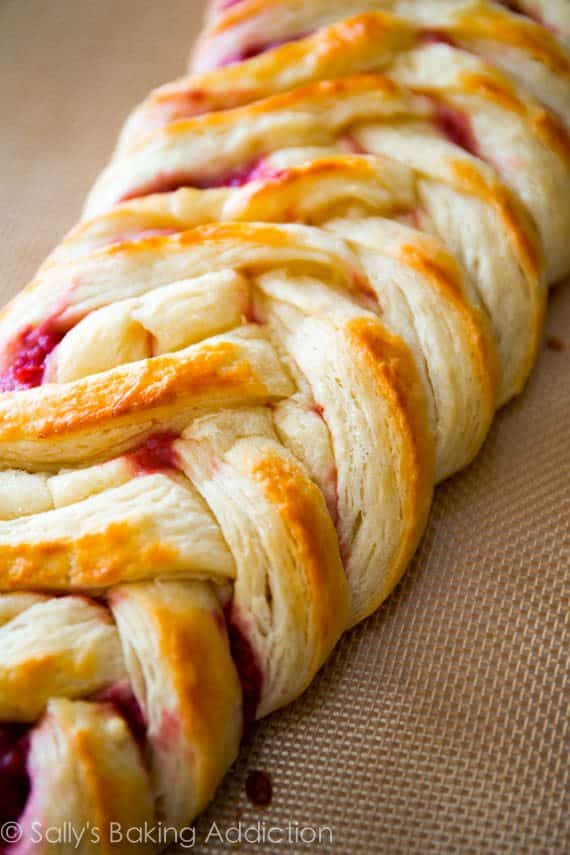
I've studied, tested, and retested plenty of homemade pastry dough the by month. (And I've gone through a few pounds of butter in the process!) The resulting dough is a quick-method to real Danish pastry. It's an adaption of several trusted sources: Cooking Illustrated, Joy of Cooking, and pastry master Beatrice Ojakangas. I mish-mashed all of the recipes I studied and made my own version of this flaky, buttery dough.
What is Danish Pastry?
Danish pastry is fabricated from flour, yeast, milk, eggs, and copious amounts of butter. The texture is similar to croissant dough, but tastes sweeter (and has the addition of egg in the dough). Like croissants, typical Danish pastry dough is rolled out thinly, and then folded with a layer of butter to grade multiple layers.
This is a Shortcut Homemade Pastry Dough
This is a shortcut version– it'due south not the traditional method of making real danish pastry. Hither we are working the butter direct into the dough using a nutrient processor. We're all the same rolling information technology out and folding the dough, just as you practise when you laminate dough with butter, only we're not folding it up with a separate layer of butter. Does that brand sense?
I use the term "shortcut" loosely. This dough yet takes at least 5-vi hours full with ii rounds of refrigeration. Pastries made from this dough are just equally buttery, tender, and flaky. You could compare this to store-bought puff pastry, but it'due south worlds better. Crispier, more than buttery, flakier, and– of course– homemade.
What Tin can I Make With This Dough?
I stick to breakfast pastries similar pastry braids and individual breakfast pastries. You'll love my raspberry pastry braid (pictured above) and blueberry cream cheese pastry braid (pictured below).

Y'all'll also dearest these breakfast pastries (pictured below).

Overview: Homemade Pastry Dough Ingredients
This yeasted pastry dough comes together with viii basic ingredients.
- Water:You lot demand 2 liquids in this dough recipe: warm water and room temperature milk. Don't apply all water or all milk; this conscientious remainder is primal. Mix the warm h2o with yeast and some granulated carbohydrate. Cover and wait until the summit is a little foamy, as pictured below. (You will do this step no matter if you are using instant yeast or active-dry yeast.)
- Yeast: You can apply active-dry or instant yeast. The instructions, amount, and recipe do not change– you will still do each of these exact steps regardless of which blazon you use.
- Granulated Saccharide: Saccharide sweetens this dough and feeds the yeast. Use 1 Tablespoon at first, then add the remainder of the sugar when you whisk in the milk, egg, and salt.
- Whole Milk: Use room temperature milk, non warm milk. For all-time taste and texture, I strongly recommend whole milk.
- Egg:1 egg tenderizes the dough. Don't skip information technology!
- Salt:Adds season.
- All-Purpose Flour:You need flour in the dough, plus a generous amount for the rolling, folding, and shaping steps. It's helpful to take plenty of extra flour on hand. I use A LOT of information technology when I'm rolling the dough and shaping the pastries.
- Cold Butter:Butter is the main ingredient in this dough recipe– you lot will work information technology straight into the flour, forming pea-sized crumbles. Merely like when nosotros make pie crust or biscuits, brand sure the butter is extra cold. If the butter isn't cold, the butter will melt, the dough volition plow to semi-liquid, and you won't take any layers or flakes in your pastry. The colder the butter (and dough), the meliorate results.
Homemade Pastry Dough Success Tips
- Use cold butter. If the butter isn't cold, the dough will melt before it even hits the oven.
- Look some butter to leak as the pastries bake. That'southward completely normal!
- The dough must be sufficiently chilled whenever y'all are working with it. Because of all the refrigeration, this dough is a wonderful recipe to get started ahead of time. You can easily brand this dough in ane forenoon or over the course of iii days.
- The temperature of your ingredients is imperative to this pastry'south success. Make sure you take the time to warm the water and bring the milk to room temperature.
- I do not recommend any substitutions in this carefully formulated dough, though a lower fat or nondairy milk works in a pinch.
- Utilise a nutrient processor for the butter/flour in stride 3. If needed, a pastry cutter works in a pinch. (Affiliate links– any processor or pastry cutter works, but both linked options are what I own and love)
- Read through the recipe, recipe notes, and meet the visuals below. Take your fourth dimension!
Video Tutorial
Exercise NOT be overwhelmed by all these steps. I intermission everything downward into detail. Be sure to utilise the photos beneath this recipe as a visual guide.
Step-past-step photos below!
Impress
Description
This recipe yields 2 lbs of dough, which equals ii pastry braids. 1 braid serves 5-vi people. If yous don't need that many tempting pastries around, freeze the second one-half of the dough for a later fourth dimension. Make-alee and freezing instructions included below.
Pastry Dough
- 1/4 cup (60ml) warmwater (betwixt 100-110°F, 38-43°C)
- 2 and ane/4 teaspoonsactive dry or instant yeast (1 standard bundle)*
- i/two loving cup (120ml) whole milk, at room temperature (betwixt 68–72°F, xx-22°C)
- 1 largeegg, at room temperature
- 1/4 loving cup (50g)granulated saccharide
- i teaspoon salt
- xiv Tablespoon s (205g) unsalted butter, cold
- ii and 1/two cups (313g) all-purpose flour (spoon & leveled), plus more for generously flouring hands, surface, and dough
Egg Wash
- 1 largeegg
- 2 Tablespoon s (30ml) whole milk
- Preliminary annotation: To assist guarantee success, I recommend reading through the recipe, watching the video tutorial, and reading the explanations below this recipe. (All answer many FAQs.) Practise not employ an electric mixer for this dough. It's best if the dough is folded together with a wooden spoon or safe spatula since it is so viscid. There is very minimal mixing required.
- Make the Pastry Dough: Whisk the warm water, yeast, and 1 Tablespoon (6g) of sugar together in a big bowl. Cover and let to rest until foamy on peak, about v minutes. If the surface doesn't take bubbles on elevation or wait foamy after xv minutes (information technology should if the yeast isn't expired), start over with a fresh bundle of yeast. Whisk in remaining saccharide, the milk, egg, and common salt. Once these wet ingredients are mixed together, lightly comprehend and ready the basin bated every bit you work on the next pace.
- Cutting the cold butter into 1/4 inch slices and add to a food processor or blender. Top with 2 and 1/2 cups flour. Pulse the mixture 12-15 times, until butter is crumbled into pea-size bits. Run into photo below for a visual. Using a food processor or blender is best for this dough. Keeping that in mind, if you lot don't accept one, yous can use a pastry cutter to work in the butter.
- Pour the flour mixture into the wet yeast mixture. Very gently fold everything together using a rubber spatula or wooden spoon. Fold *just until* the dry ingredients are moistened. The butter must remain in pieces and crumbles, which creates a flaky pastry. Turn the viscid dough out onto a big piece of plastic wrap, parchment paper, aluminum foil, or into whatsoever container yous tin tightly cover.
- 1st Refrigeration: Wrap the dough/cover upwardly tightly and refrigerate for at least iv hours and upwards to 48 hours.
- Scroll & Fold: Take the dough out of the refrigerator to begin the "rolling and folding" process. If the dough sat for more than 4 hours, it may have slightly puffed up and that's ok. (It will deflate as you shape it, which is also ok.) Very generously flour a work surface. The dough is very sticky, so make sure you have more flour nearby as you roll and fold. Using the palm of your hands, gently flatten the dough into a small square. Using a rolling pivot, roll out into a 15×8 inch rectangle. When needed, flour the work surface and dough as you are rolling. Fold the dough into thirds as if it were a business concern letter. (See photos and video tutorial.) Turn it clockwise and ringlet it out into a fifteen inch long rectangle once more. Then, fold into thirds again. Turn it clockwise. You lot'll echo rolling and folding ane more fourth dimension for a full of 3 times.
- 2nd Refrigeration: Wrap up/seal tightly and refrigerate for at least 1 hour and upwards to 24 hours. Y'all can too freeze the dough at this indicate. See freezing instructions.
- Line two large baking sheets with parchment newspaper or silicone blistering mats. Rimmed baking sheets are all-time considering butter may leak from the dough equally it bakes. If you lot don't have rimmed blistering sheets, when it's time to preheat the oven, place another baking canvass on the oven rack beneath to grab whatsoever butter that may drip.
- Take the dough out of the refrigerator and cutting it in one-half. Wrap 1 half up and keep refrigerated as you piece of work with the offset half. (You can freeze half of the dough at this signal, use the freezing instructions below.)
- On a floured work surface, roll dough out into a 12×8 inch rectangle. You can roll out the dough on a lightly floured piece of parchment paper or lightly floured silicone baking mat instead because you will transfer the shaped dough to a lined baking canvas side by side.
- Using a sharp pocketknife, cut off 2 corners of the dough (on ane 8-inch side) and so two modest triangles three inches autonomously from each other on the other end (the other eight-inch side). Run across visual below.
- Spread 1/2 of the filling (raspberry or cream cheese) downward the length of the center of the strip, which should be near 3 inches broad. Using a sharp knife, pastry wheel, or pizza cutter, cut 10 slanting strips (3/4 – 1 inch wide each) along both sides. Fold strips over filling, alternating each side to resemble a twist or a braid. Fold the bottom cease up to seal the filling inside. Echo with the second one-half of the dough and the rest of the filling. The braids may seem very narrow, merely they puff up and out equally they bake.
- Egg Wash: Whisk the egg launder ingredients together. Brush all over the dough.
- I strongly recommend refrigerating the shaped braids before blistering for at to the lowest degree 15 minutes and up to one hr before blistering. The braids tend to leak more butter and/or lose more than shape if they haven't chilled.
- Preheat oven to 400°F (204°C).
- Bake each braid for 18-22 minutes or until golden brown. Some butter may leak from the dough, that's completely normal and expected. Feel free to remove the baking sheets from the oven halfway through baking and brush the dough with any of the leaking butter, then place back in the oven to finish baking. (That's what I do!)
- Remove baked danish braids from the oven and cool for at to the lowest degree 5 minutes before cutting and serving.
Notes
- Make Ahead & Freezing Instructions: Prepare the dough as instructed in steps 2-four. At this point the dough can be refrigerated up to 48 hours. Yous tin can likewise prepare the dough through stride 6. At this point the dough can exist refrigerated upwards to 24 hours. During or after this second chilling time, you could too freeze the dough for upward to 1 month. (I don't recommend freezing the dough before the rolling and folding pace.) Thaw overnight in the refrigerator, then go on with pace eight. Y'all can also freeze the shaped and filled braids after shaping them in step 12. Thaw in the refrigerator, then proceed with stride 13.
- Temperature & Substitutions: The temperature of your ingredients is imperative to this pastry's success. Make sure y'all accept the fourth dimension to warm the water and bring the milk to room temperature. Keep the butter in the fridge until you need it in step 3. I practise not recommend any substitutions in this carefully formulated dough, though a lower fatty or nondairy milk works in a pinch. For the egg wash, depression fatty or nondairy milks work, every bit do heavy cream or half-and-half.
- Yeast: Y'all tin can use either active dry yeast or instant (quick rise) yeast. The instructions and amount are exactly the aforementioned no matter which yous use. Reference my Baking with Yeast Guide for answers to common yeast FAQs.
- Halve the Recipe? I don't recommend halving this dough recipe. Brand the dough equally written, then freeze half after step 9.
- Special Tools (affiliate links): Food Processor (I own and love this one), Pastry Cutter, Pastry Brush, Rolling Pin, Rimmed Baking Sail
- Dough recipe adapted from Cooking Illustrated, Joy of Cooking, and Beatrice Ojakangas
Keywords: homemade danish pastry dough, danish pastry dough
Step-By-Step Photos
Whisk the warm water, yeast, and 1 Tablespoon of carbohydrate together. Cover and allow to residue until foamy/bubbly on acme:
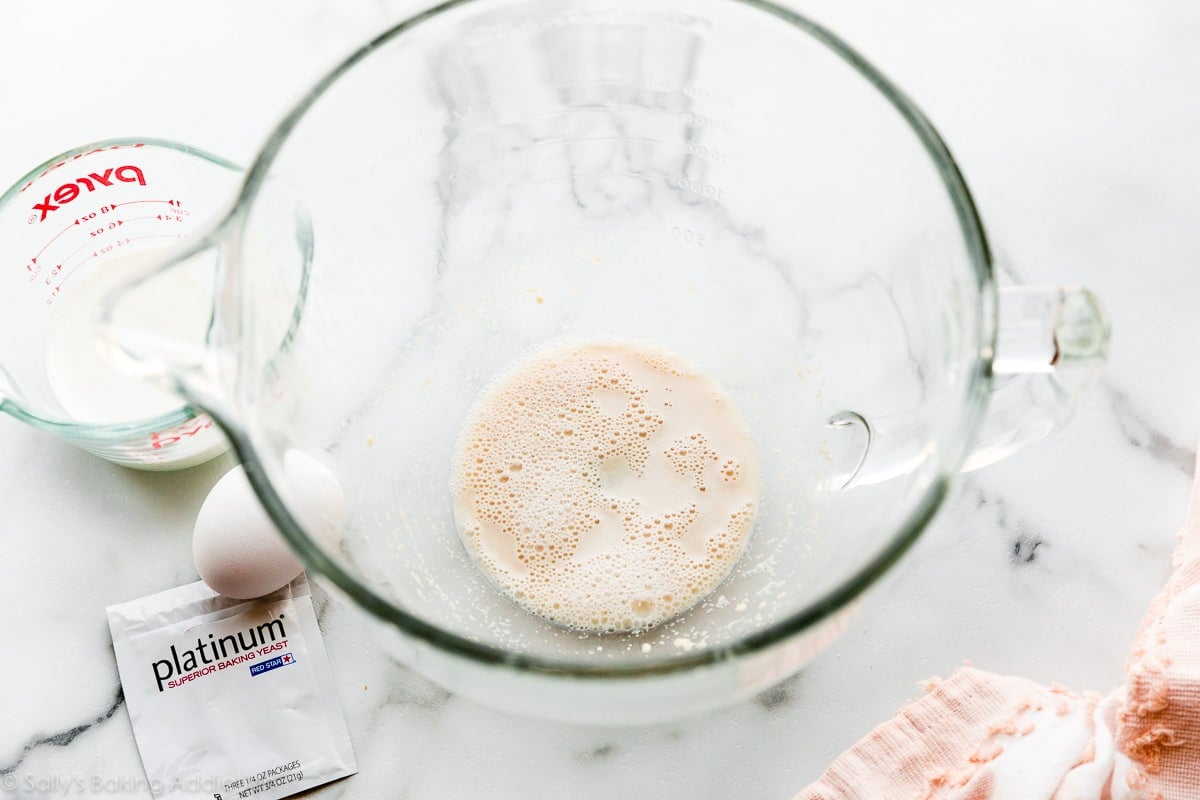
Whisk in the rest of the sugar, the milk, egg, and salt. We'll telephone call these the wet ingredients:
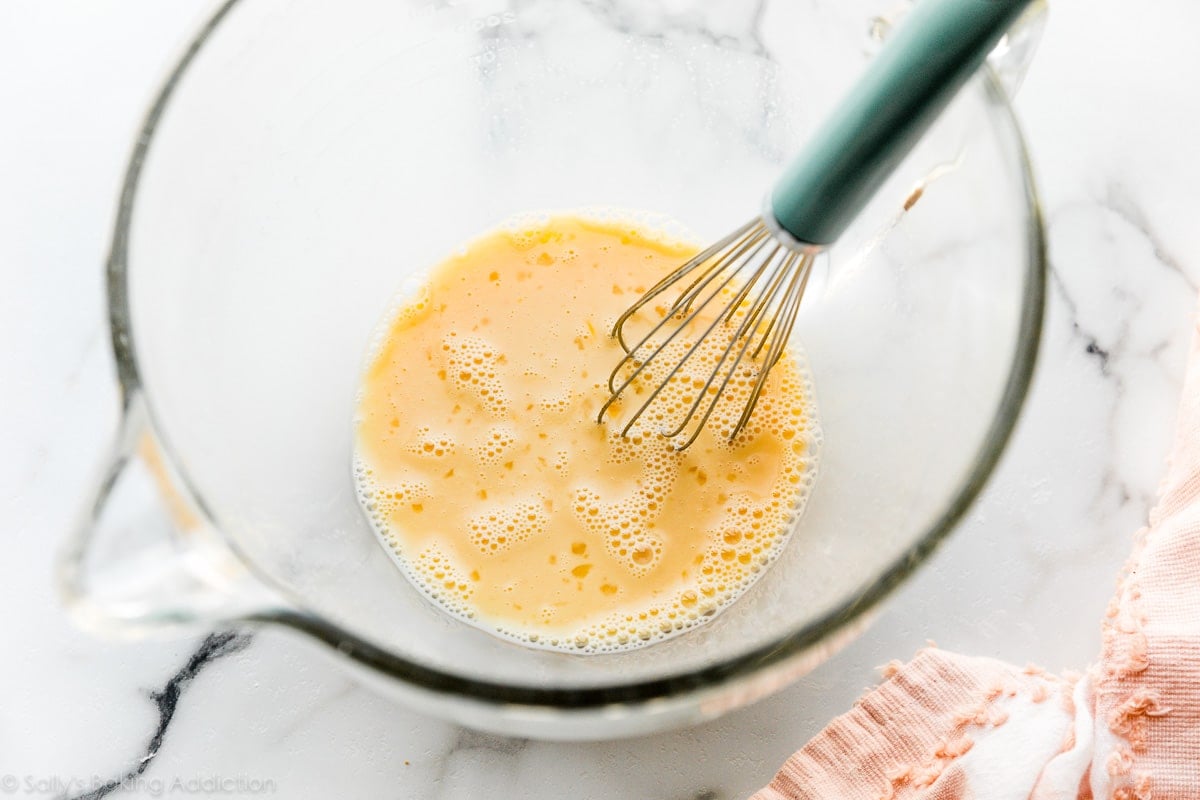
You need a food processor blender for this recipe. If you accept neither, use a pastry cutter to cut the cold butter into the flour. An electrical mixer will non work for this footstep. You are looking for pea-size crumbles of flour coated butter. This stride is simply possible if the butter is common cold.
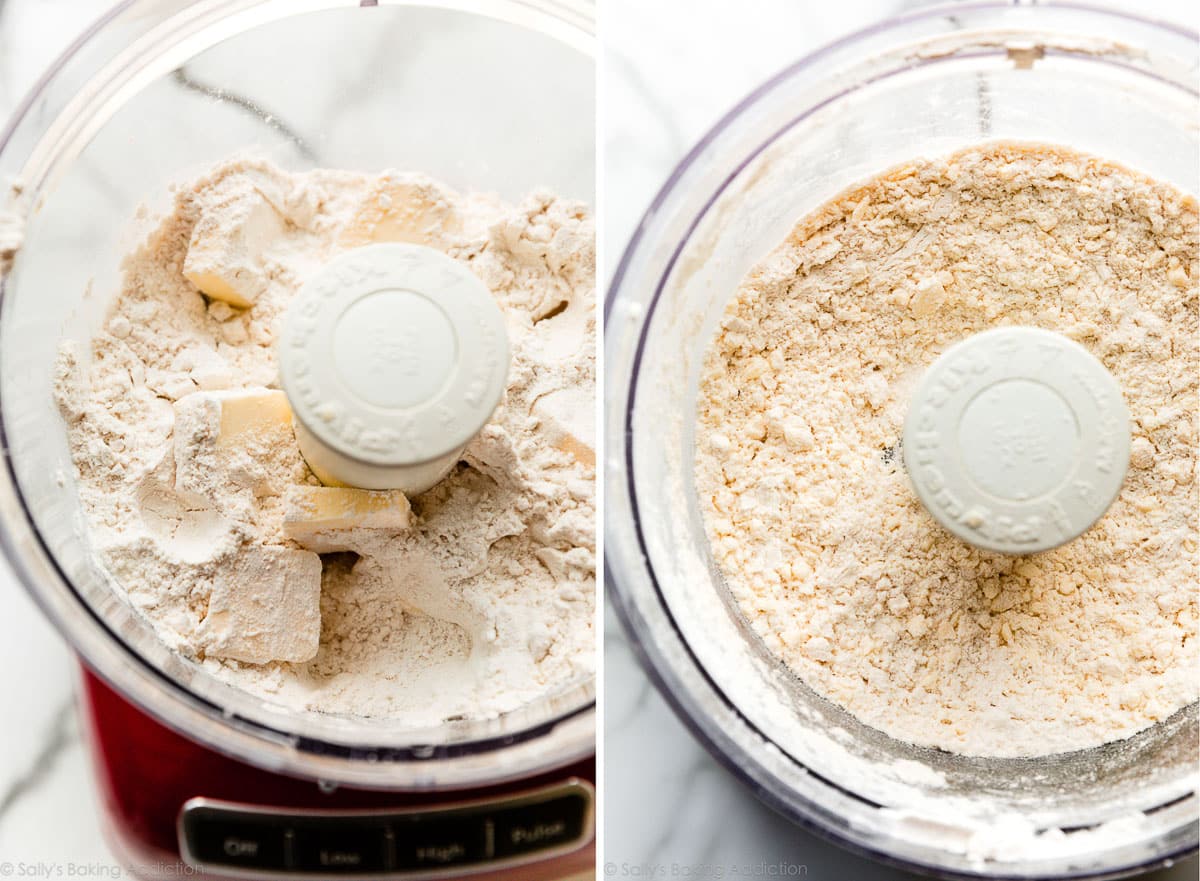
Pour the butter/flour crumbles into the wet ingredients and fold it together using a wooden spoon or safety spatula. Information technology is very gluey. Since this dough is and so pasty, I do not recommend using an electric mixer. Information technology volition create a huge mess! There is minimal mixing required anyway– nosotros don't want to overwork this dough.
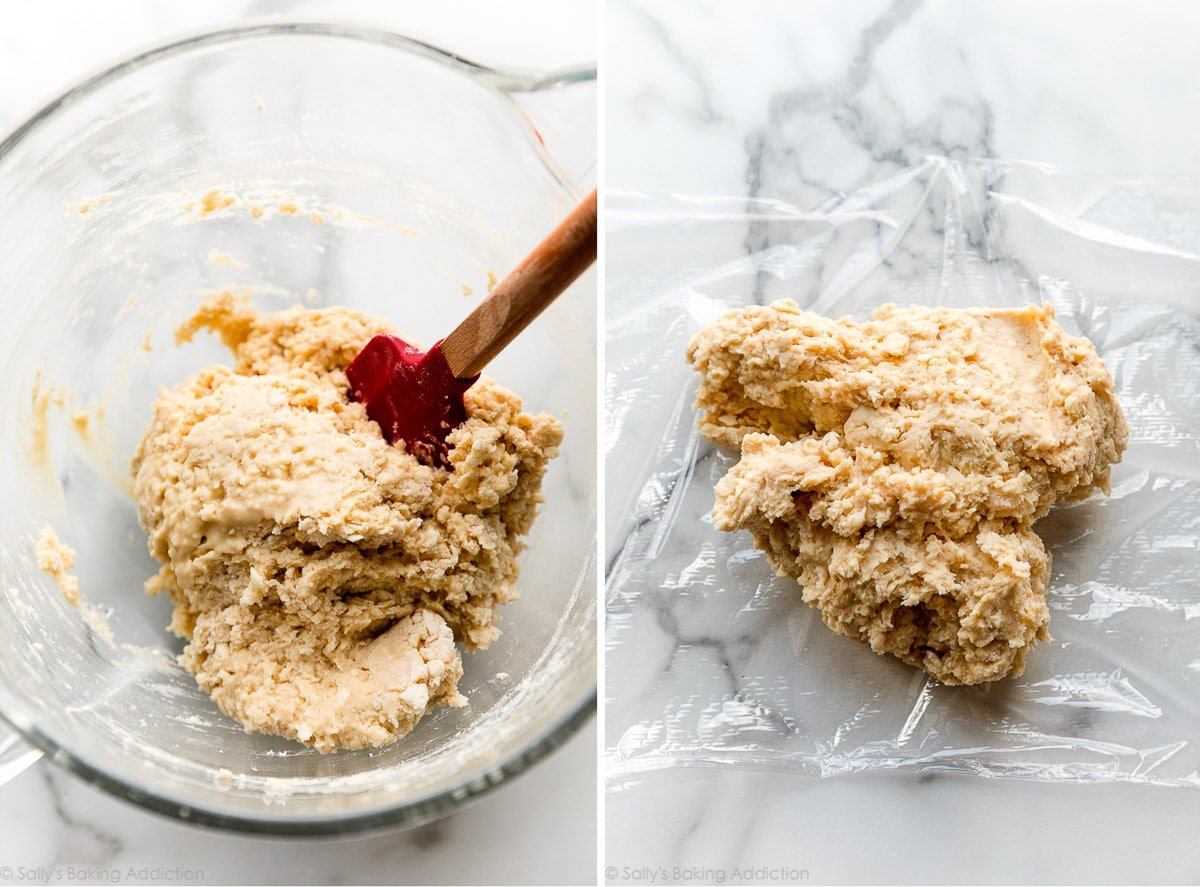
You'll notice many bits of butter still visible in the dough– that'south a Adept thing! Wrap the dough up tightly and air-condition for at least 4 hours and up to 48 hours.
This is the 1st refrigeration.
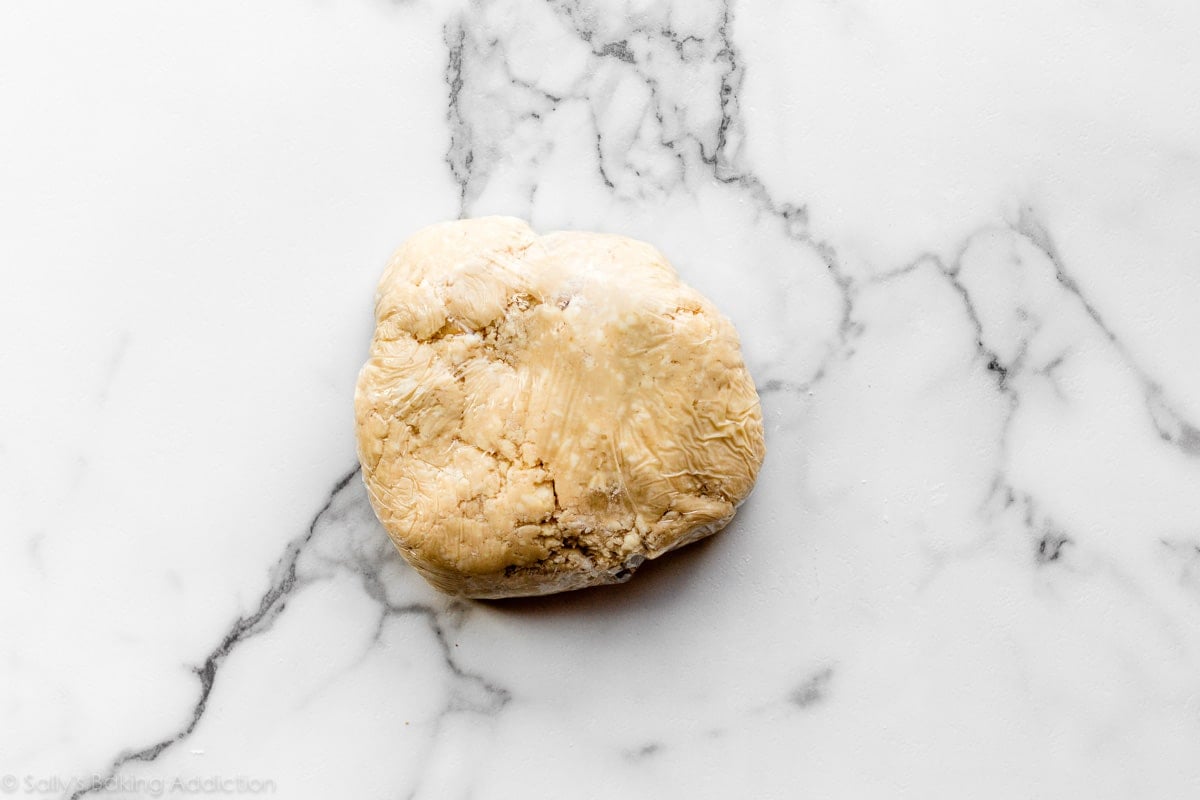
Shortcut Lamination
Now let's do a variation of laminating aka rolling and folding dough and butter together. Remember when we fabricated croissants and laminated the dough with a sheet of butter? The butter is IN this homemade pastry dough. And then, instead, nosotros're simply rolling and folding the dough itself. Roll information technology out into a 15×eight inch rectangle:
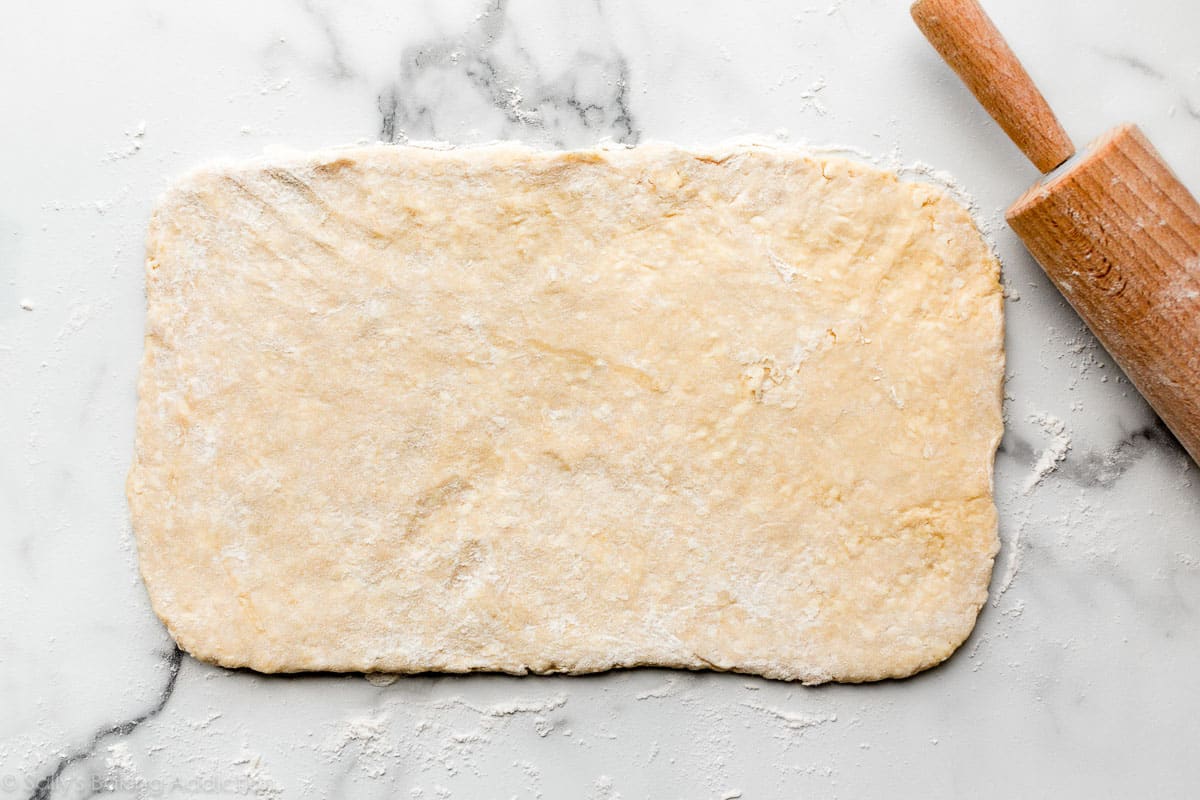
Fold it in thirds like a alphabetic character:
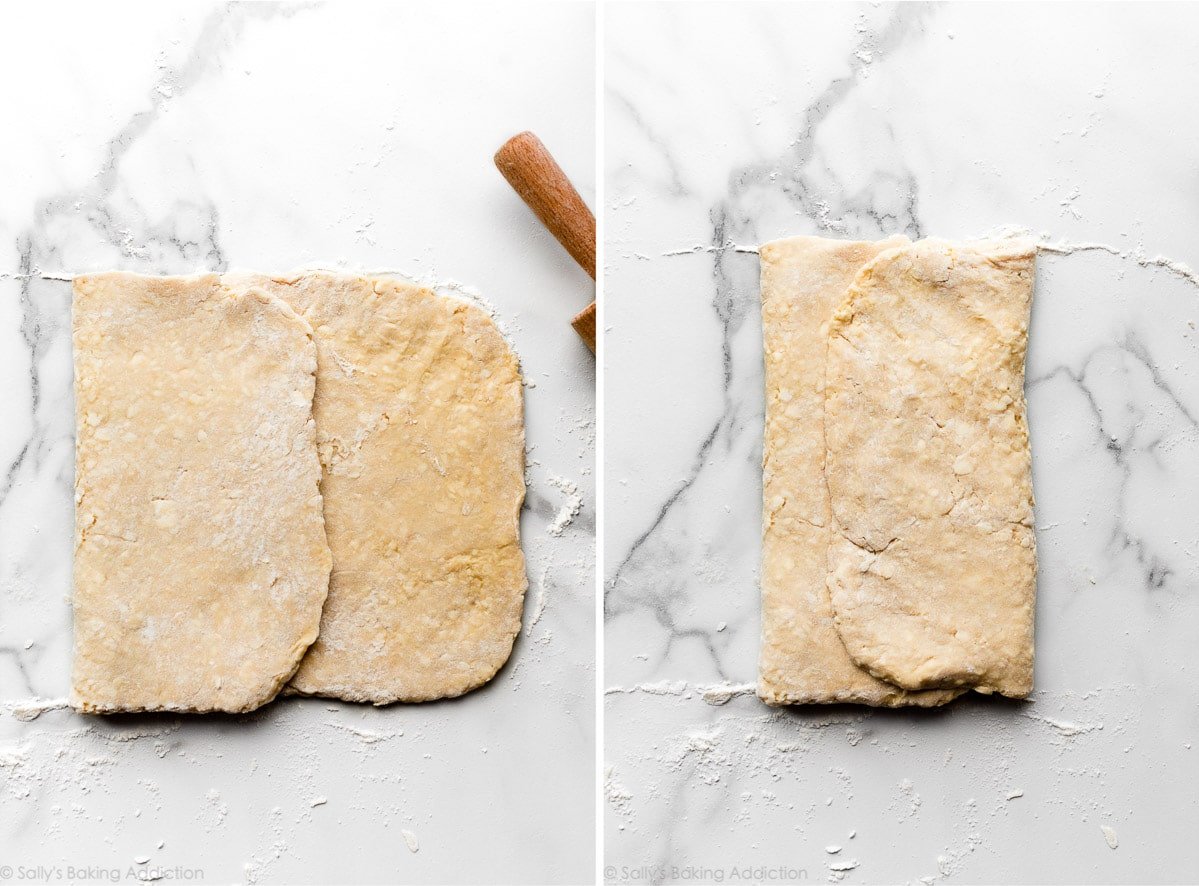
Turn it clockwise:
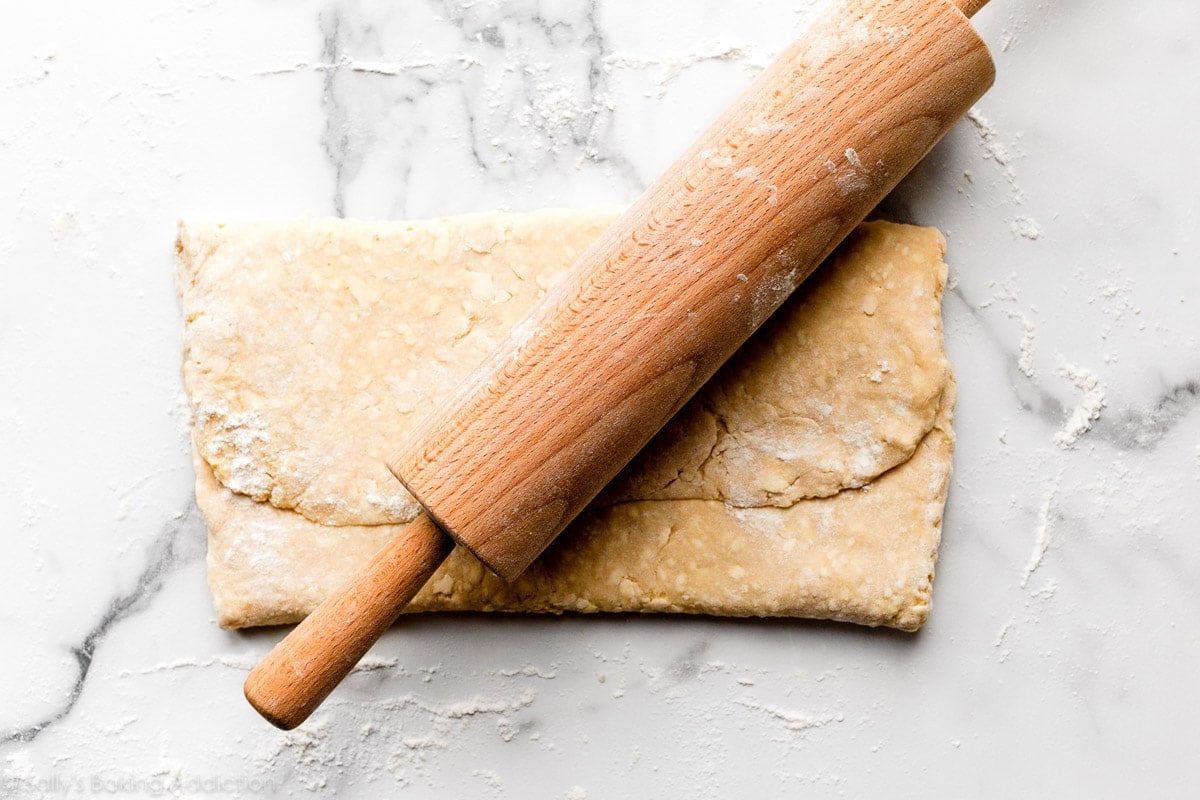
And then roll it out into a fifteen-inch rectangle once more. Echo the folding. Turn it clockwise again. Repeat rolling and folding one more time for a total of 3 times. Wrap the laminated dough up tightly and refrigerate for at least 1 hr and up to 24 hours.
This is the 2nd refrigeration. After this 2d refrigeration, you tin move on to shaping your dough based on what y'all're making like individual danishes or pastry braids. The total written recipe to a higher place includes the steps yous need to make a pastry braid. Here'due south how to make individual breakfast pastries.
Shaping the Pastry Braid
Cutting the dough in half.
This recipe yields 2 lbs of dough, which equals ii braids. one braid serves five-6 people. If you don't need that many tempting pastries effectually, freeze the 2d half of the dough for a later time. All make-ahead and freezing instructions in the recipe above.
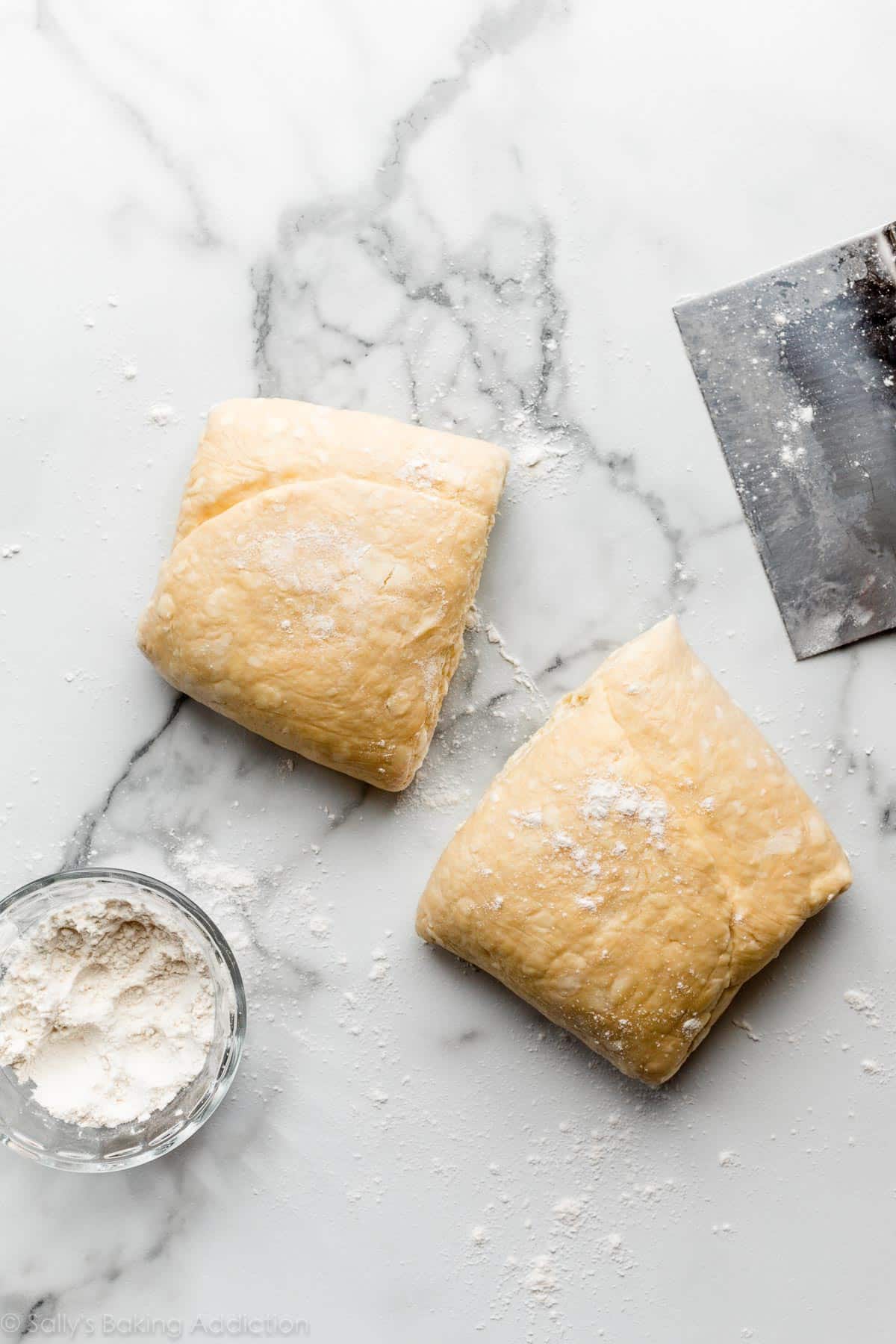
Piece of work with only half the dough at once. Wrap half up and refrigerate until ready to use. Curl the half of dough into a 12×8 inch rectangle.
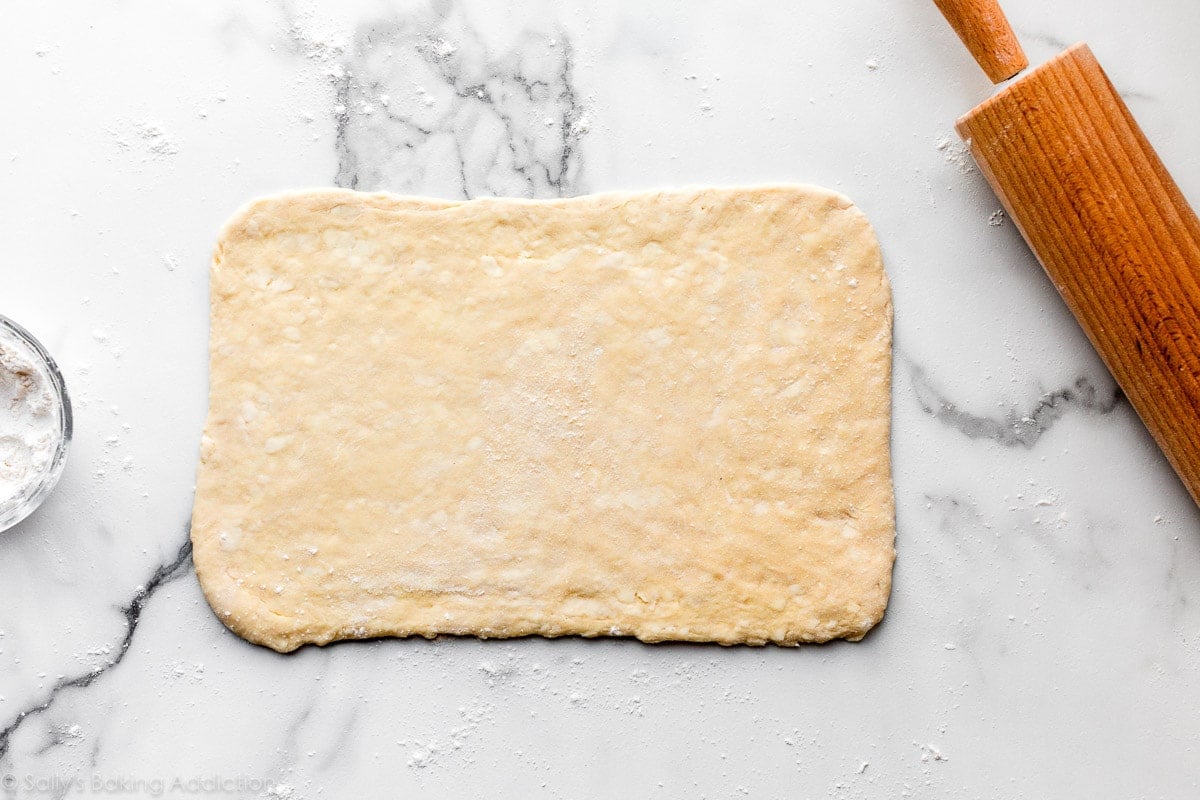
Transfer to a lined baking pan. Using a sharp knife, cut off two corners of the dough (on one 8-inch side) and and so two small triangles iii inches apart from each other on the other end (the other eight-inch side):
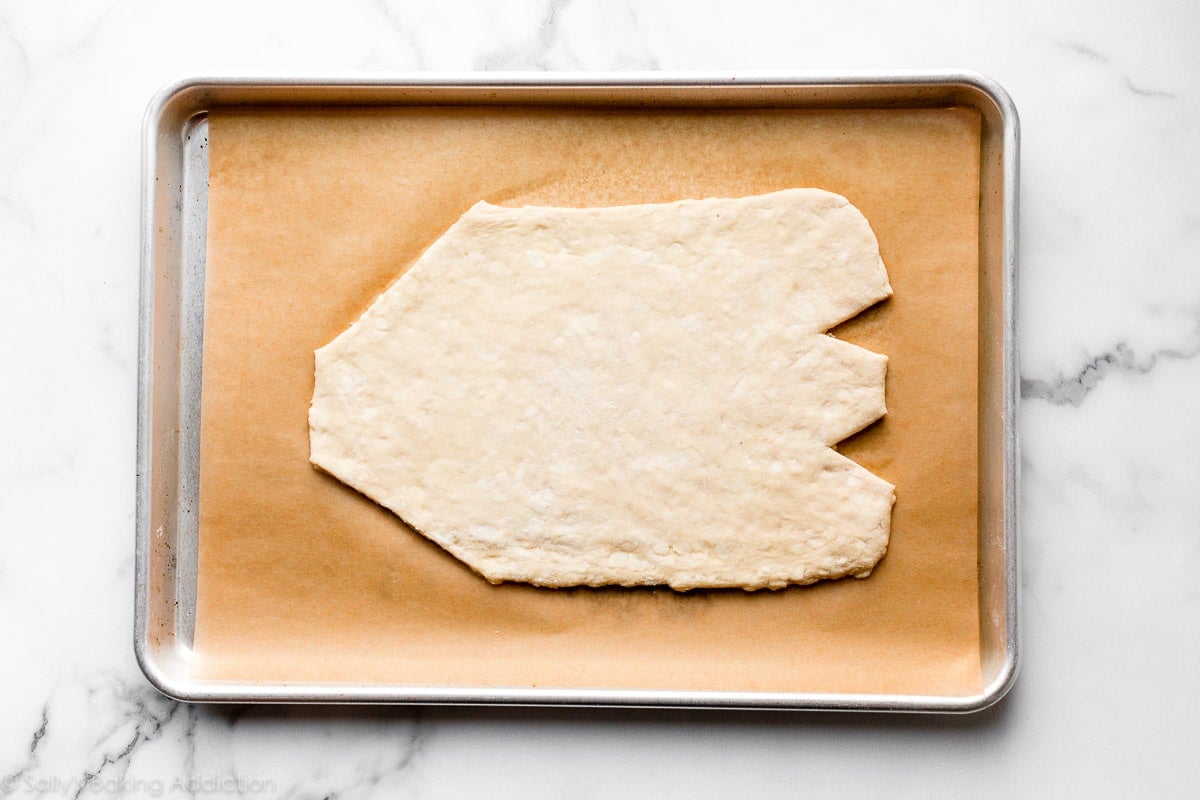
Spread 1/2 of the filling (raspberry or cream cheese) down the length of the middle of the strip. Using a sharp pocketknife, pastry wheel, or pizza cutter, cut 10 slanting strips forth both sides.
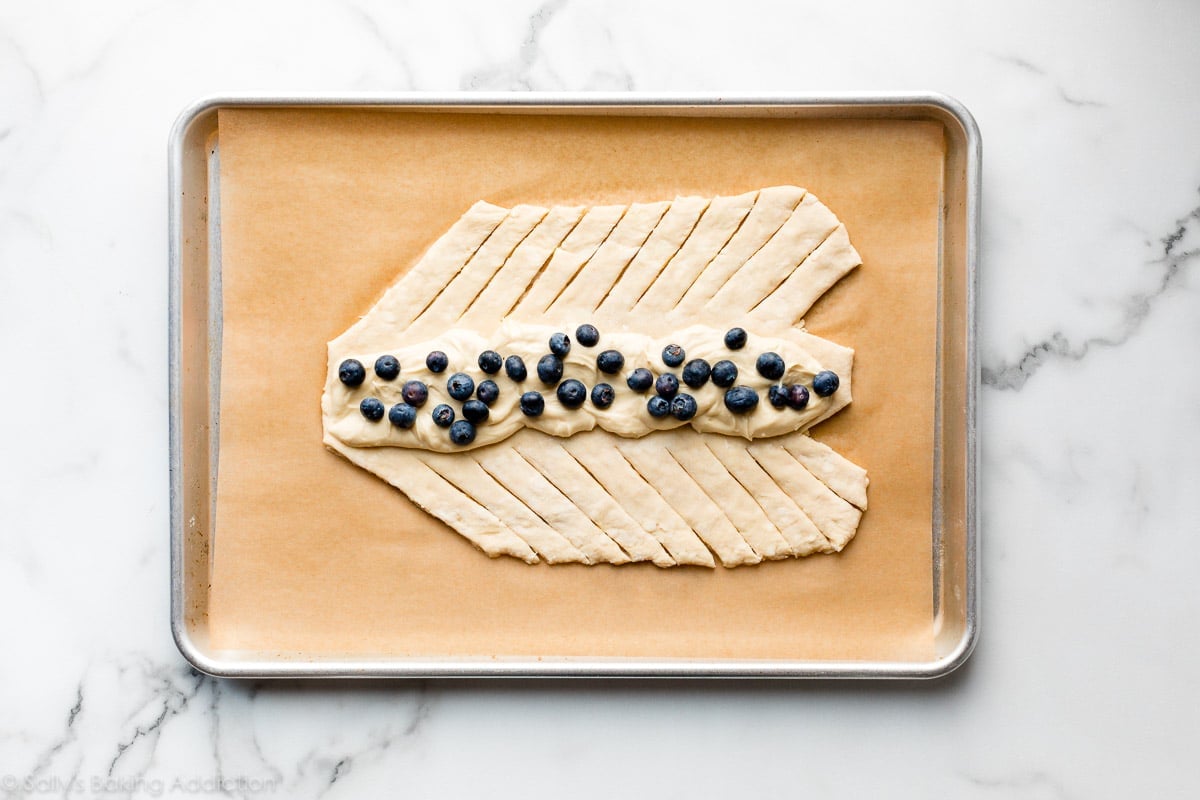
Fold strips over dough, alternate each side to resemble a twist or a braid. Fold the lesser stop up to seal the filling inside. The braids may seem very narrow, but they puff up and out as they bake.
Brush the shaped dough with egg wash, which is a combination of 1 egg and milk. What is the purpose of an egg wash? It guarantees a shiny and well-baked gilded crust.
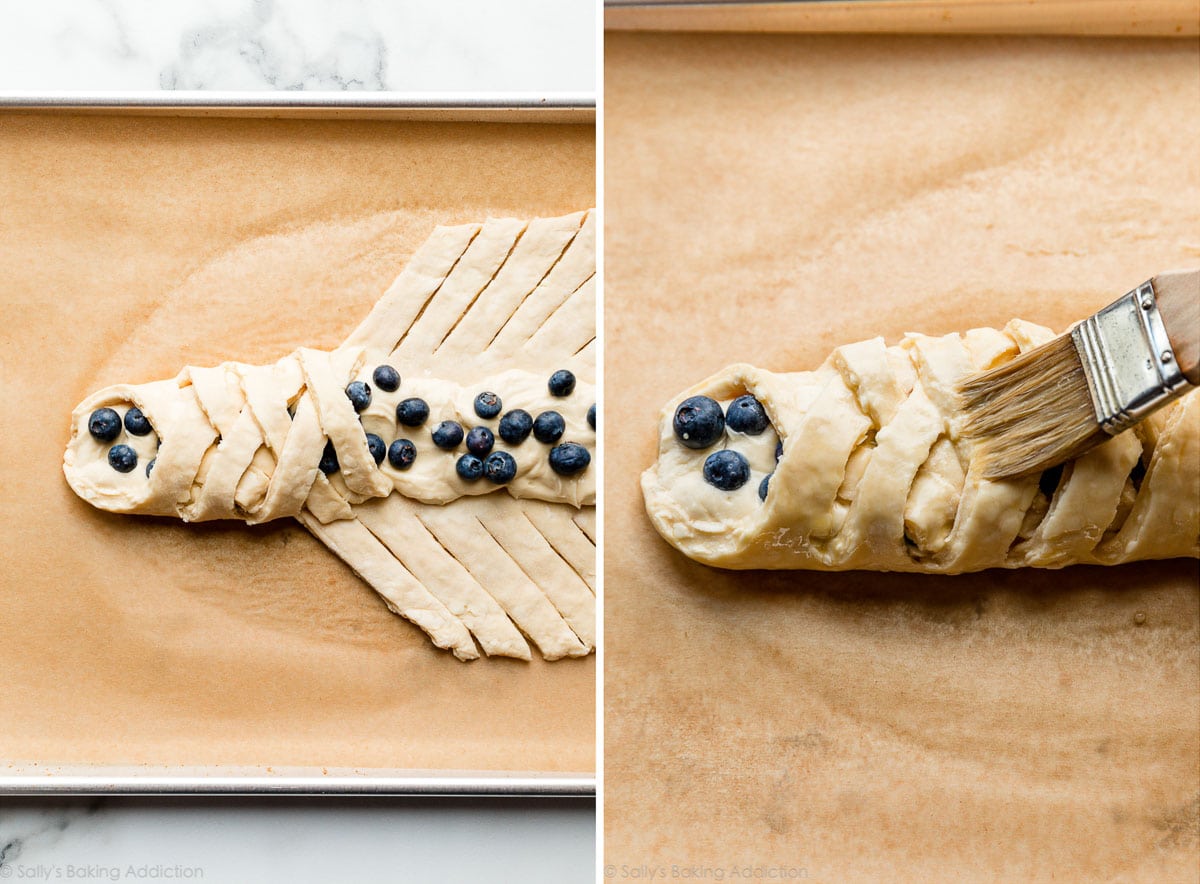
To help guarantee the braids hold their shape, chill them in the fridge as the oven preheats and even upwards to ane hour.
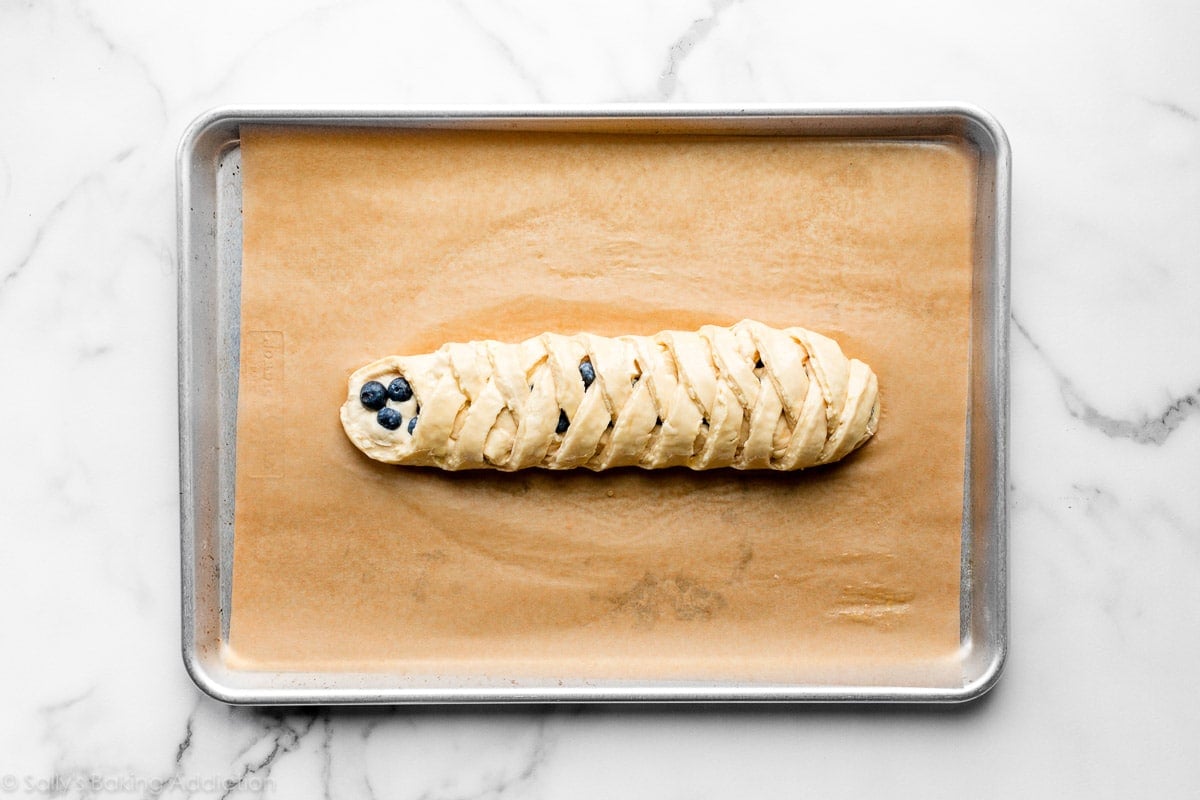
Broil until aureate chocolate-brown.
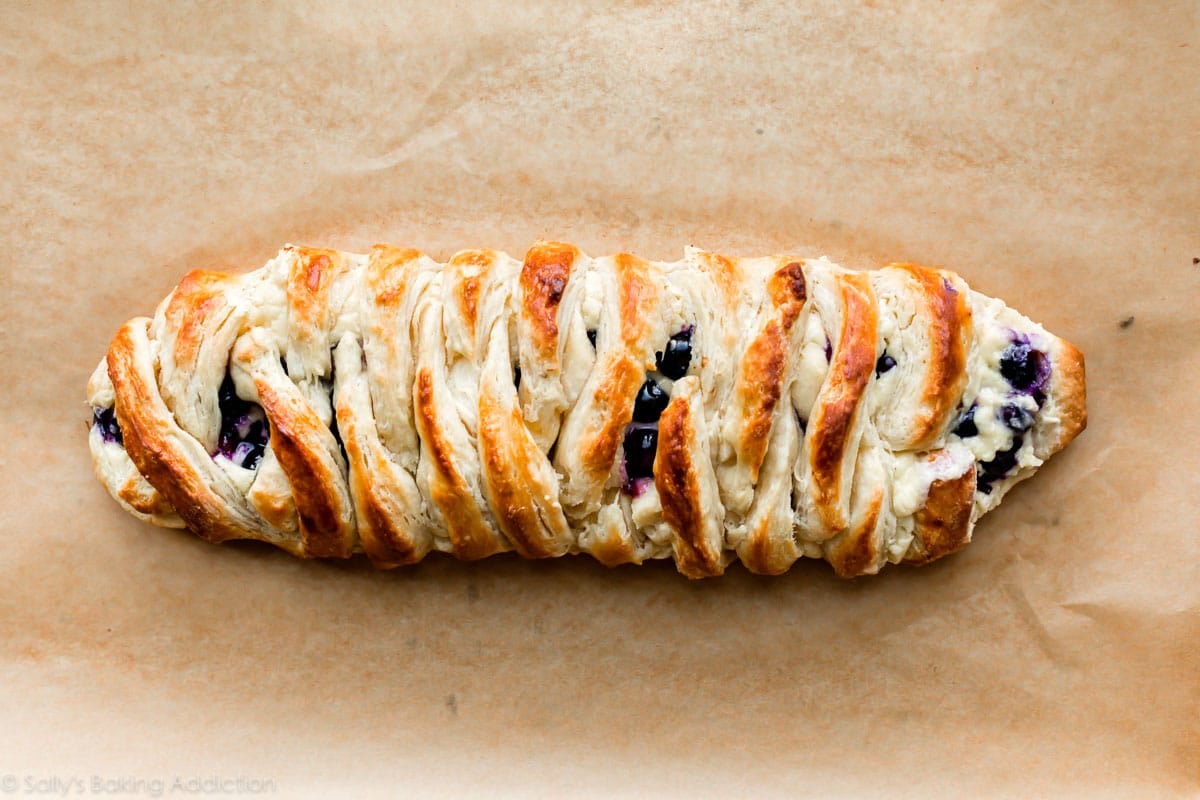
Subscribe
Baking Made Easy
Are y'all new to this website? This email serial is a great place to commencement. I'll walk you through a few of my virtually popular recipes and bear witness you exactly why they work.
Source: https://sallysbakingaddiction.com/danish-pastry-dough/
0 Response to "How to Make Danish Fresh Again"
Publicar un comentario